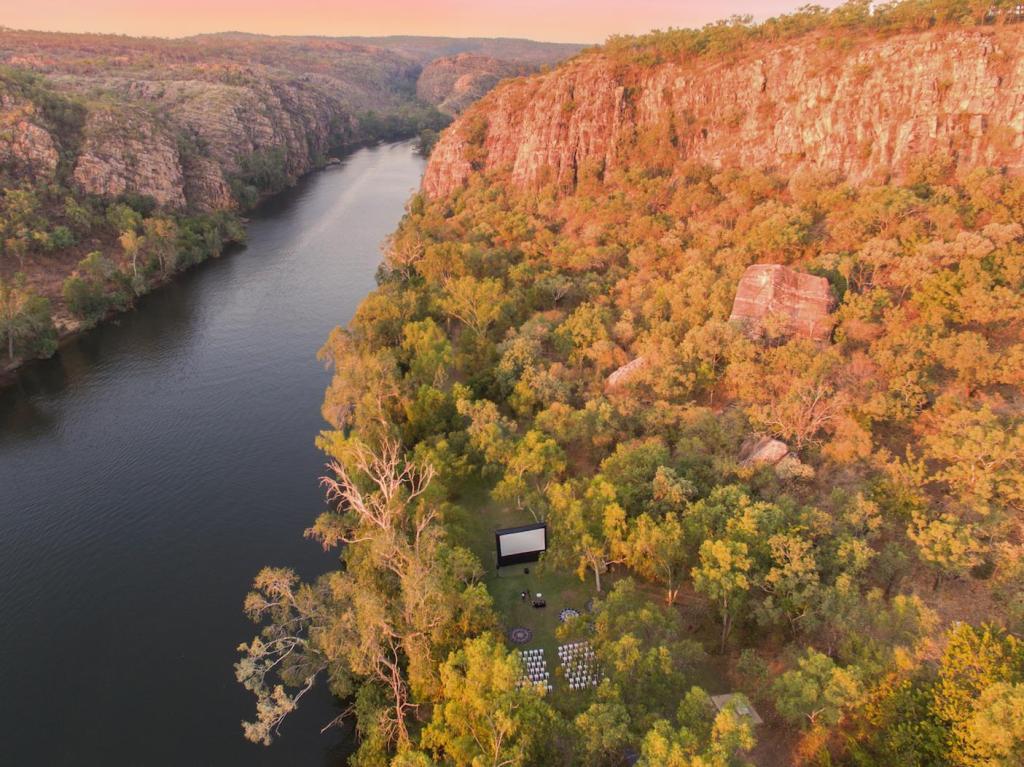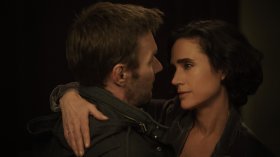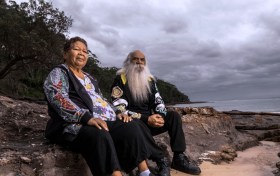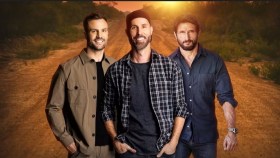Australia’s most stunning outdoor cinema? Nitmiluk in the Northern Territory. Image supplied by NTTFF.
Deckchairs and mozzies. Outdoor cinemas are nothing new, but the Northern Territory Travelling Film Festival (NTTFF) is literally a world away from the urban comforts of rooftop bars or Botanic Gardens. The floors are made of red dust, and when the lights go down, the stars you’ll see won’t be Hollywood ones. Which is not to say there won’t be luxury bush-tucker snack-packs at some locations; or ‘glamping’ options for tourists.
‘Our festival is all about creating a cinematic experience outdoor under the stars in towns, remote Indigenous communities and iconic NT environments, all powered by a solar setup,’ explains Festival Director Britt Guy in an email interview with Screenhub. ‘It is deeply committed to NT stories and to sharing them in the places with the people they are about, providing high quality film experiences on country.’
Now in its second year, the NTTFF opens this Saturday night (30 March) at Ooraminna Homestead, 30 ks outside of Alice Springs. A week later, it will pop up in Tennant Creek, then Daly Waters, Darwin, Nitmiluk National Park, Edith Falls, Kakadu, and finally, on 1 June, Nhulunbuy on the Gove Peninsula in Northeast Arnhem Land.
The seasonal forecast for this part of the world is warm and clear. That’s important. As Guy explains: ‘The festival runs from March till June in order to work alongside the NT weather patterns. Central Desert is starting to cool down from March so we want to have screenings in this region before it is too cold to be out under the stars, while in the Top End we have to wait for the tropical wet to end, and creeks and rivers to subside so we can access locations for beautiful nights in our dry season.’

Image: NTTFF Festival Director, Britt Guy. Supplied.
At most of the locations, the one-night program consists of a feature-length collection of short films, TV and media made by NT filmmakers and communities. These are films celebrating the stories, landscape and culture of the region and they include: Grant Thomas’s 17 minute Lil Bois, the first short film in the traditional language of Ngadi; the brightly painted and animated Tangentyere Artists Film Collection, and Sunset, Jane Hampson’s 10-minute drama about a lonely 89-year-old woman encountering a new connection. In a couple of the locations (Wurrumiyanga, Nitmiluk and Kakadu), Wayne Blair’s much anticipated feature film Top End Wedding have special screenings. Naina Sen’s feature documentary The Songkeepers , about an Aboriginal women’s choir touring Germany, will also be screened at certain locations.
The travelling festival has two strands: one consisting of the iconic screenings; and the other of screenings accompanied by filmmaking and storytelling workshops held in remote communities, with the intention that these will foster talent for future festivals, as last year’s workshops did for this year. These workshops aim to work for three key groups – emerging filmmakers, established filmmakers, and young people, while current local equipment is audited and classes are delivered according to needs and skills.
From the brick walls of Screenhub’s city office, it’s hard to imagine exactly what’s entailed in running a festival like this, so we asked Britt Guy to run us through the challenges (and evident delights) of this event, which has plans afoot already as far into the future as 2022.
How long have you been involved, and will this year’s festival be different to last year’s?
I have been involved since NTTFF’s inception in 2017 in partnership with Darwin Film Society, who run Darwin’s beautiful permanent outdoor cinema – Deckchair Cinema.
Last year was NTTFF’s inaugural year so there was a lot of work on the logistics of the tour – how do we move our cinematic experience through the NT across dirt and corrugated roads, river crossings and up and down the iconic Stuart Highway? We were also meeting our audiences for the first time so we were exploring the program’s appeal and strengthens and weaknesses.
This year we’ve been able to build off all our logistics knowledge and add to it with five new locations. We have also been able to further develop our program to include full length features including The Song Keepers and Top End Wedding. Our Industry Program has also deepened as we connect with filmmakers for the second year and are lucky enough to tour films that had outcomes last year.
All but one of your venues is outdoors. Does this pose particular technical or weather challenges? Is a festival like this a logistical nightmare?
The weather and environment in the NT is spectacular and something to honour, and those that call the NT home have a deep love for the outdoors. We are also very lucky with our seasons – for the most part we know when there will be rain and not. Fingers crossed. The screenings being outdoors are just how we do life in the NT and so feels very natural. We travel with a Troopy and a solar powered trailer from Katherine Regional Arts so we are fully self-sufficient, this gives us a huge amount of freedom and the ability to setup in front of the best natural backdrops. The festival has come out of long-term partnerships I have developed through working in the NT, and new partnerships I have developed for this festival. We work closely with local community organisations and tourism partners to put the festival on so that it reflects the people of the NT and that comes right through to the logistics – we aim for organised, laid back and flexible.
What are your tips for running a good outdoor screening event?
Haha see the above: organised, laid back and flexible, and with a clear understanding of the place where the event is being held and the local and visiting people that will attend. [You want] connected audiences with new places, or old places reimagined. [This makes for] is an exciting offering to all involved. Too often place gets forgotten.
Is it hard to get audiences on board for these screenings? What do we know about attendance?
We have two streams of screenings – Iconic and Community. Iconic events are advertised locally, Territory-wide and nationally and attract locals and tourists alike. Community events are advertised within community and for remote local audiences to attend. Our experience from last year was that audiences embraced the screenings and found the opportunity to be under the stars sharing in cross cultural films about our region a special way to spend an evening.
We reach audiences through the usual channels of radio, print and social media – as well as having a strong focus on local word of mouth throughout community and industry partners.
How big a part of your audience is the tourist audience?
Tourists attend our Iconic screenings, and last year was one third of this audience. As the festival grows, I imagine that number will grow as well. I hope visitors begin to put our beautiful NT cinema under the stars on their must do list! Epic landscapes and curated films from the region you’re visiting – what more could you want?
What are the locations and screenings you are personally most looking forward to?
Ohhhh lots!! Ooraminnna Homestead will be beautiful; I stayed out here last year and it is just beautiful – the place’s connection to filmmakers and most recently to Sweet Country [which shot the outdoor cinema scenes there] made it the perfect choice for our opening night of the iconic screenings! Seeing the beautiful Tangentyere Artists animations as part of the Short Film program will be very special!
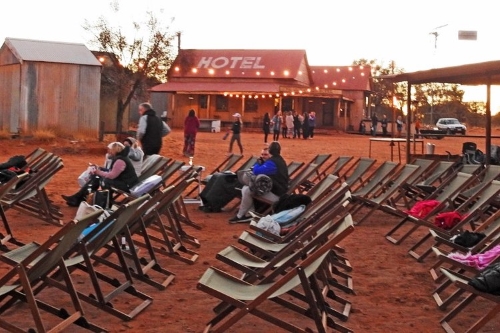
Image: Ooraminna Homestead – also features a film set originally built to film Ted Egan’s The Drover’s Boy.
I am also very excited to head to Ngukurr – I only visited this community for the first-time last year with NTTFF and there is an amazing film making industry in existence in this region and I it will be so wonderful to share Lil Bois and I am Numamurdirdi, both of which were made in Ngukurr, on the big screen!

Image: Still from Lil Bois, created by Ngandi man Grant Thompson and produced by Ngukurr Story Projects. This film also featured on opening night of Flickerfest in January. Source: Supplied.
Finally another new location for NTTFF but a place close to my heart – Wurrumiyanga (Nguiu) on the Tiwi Islands will screen Top End Wedding which was partly filmed on the island and with a bit of local extras cast. It is going to be a night to be remembered!
How does the program of the festival get decided and how do you select the films?
The program is decided by a committee curatorial advisory committee made up of cultural mentors/Elders, NT screen industry, NTTFF community venue and tourist partners, Darwin Film Society board and filmmakers. We look to films that have been created and released over the previous year and showcased at Darwin International Film Festival, as well as the films we see as part of our local program and created through the Industry Development Program.
Your background is in community development. What exactly is that, and what are the particular skills you bring to running this kind of event?
Community development is a process of empowering a community through knowledge, skills and experiences to create change. My background is community cultural development, so using art and culture as the entry point for the activation of change. When creating the NTTFF I looked to the community, the audiences and the filmmakers as sources of inspiration to shape the program and the screenings. [We wanted] to highlight existing community knowledge, skills and experiences and also to begin to explore what the future might hold.
NTTFF provides uniquely NT stories on the big screen for uniquely NT audiences or those that are visiting who wish to learn about the place. The opportunity for audience to have their stories reflected back to them on a big screen, with faces, places, language and stories that resonate with them is an invaluable opportunity for community connections, refection, and the beginning of conversations – conversations that often lead to change at all levels. These conversations hopefully are also had by those visiting the NT, who then return to their home and share their insights, learnings and experiences of the NT and its people.
Our festival is grounded in community feedback, industry development and advocating for the wildly talented filmmakers telling stories across the Territory.
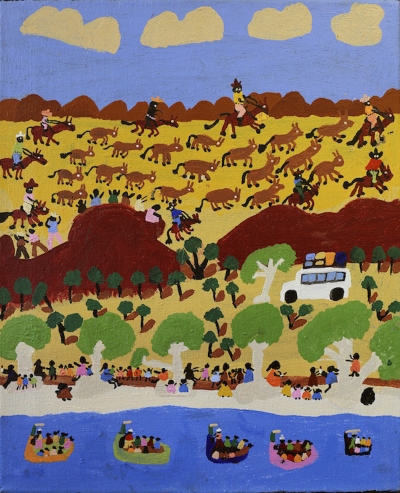
Painted still from ‘Larambal Love Story’ which features as part of the Tangetyere Artists Film Collection. Source: Supplied.
Can you explain how the workshops in remote Indigenous communities will operate? What are your goals for these sessions and what are the challenges?
We support Industry Development programs in a number of remote communities. Our experience is that our partners vary from long term established media organisations, bespoke film hubs and emerging young filmmakers. Each program is created in partnership with the community partner and local film makers and the programs and outcomes are as diverse as the filmmakers. This year’s program included the support of a writer’s room for a new web series, through to workshop in school holidays in youth centre. The goal of the program is to continue to support the industry through our Territory-wide profile, create a vehicle for sharing the diverse films being created in the NT and facilitate professional development opportunities on country.
The biggest challenge, I think, is that there is a lack of knowledge and understanding about how epic the NT film industry is, and the breadth and depth of work being made. NT filmmaking has been around a lot longer than the NTTFF and we see our role is to add another voice to champion our region’s stories and the quality of remote film making.
What is your favourite part of the job? And least favourite?
I run ACCOMPLICE, a company that produces a range of creative and cultural programs out of Garrmalang/Darwin on Larrakia land. NTTFF is one of our programs. Favourite parts of NTTFF are the stories, the places and the audiences we connect with. I love getting to travel across the beautiful moody country of the NT and sharing this unique program with some of the remotest audiences in Australia. I also love advocating for this program and the films, filmmakers and audience that make it up. To be honest I don’t think I have a least favourite…
If you could tell mainstream urban Australia one thing about the Northern Territory what would it be?
That it is a magical place filled with epic places, people and adventures. It has a lot to teach us about the political decisions we have made historically right through till today and the impact they are having on Indigenous lives every day, and the flow-on effects that are being seen across our communities. We need to start listening to this country and its First People through their experiences, culture, stories and their films.
